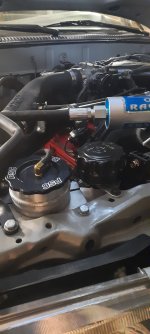Great thread! I have run into cavitation issues on my new build and was looking for a little input from the brains in here.
I'm pretty new to all of this stuff and built a front/rear steer buggy. I got a PSC system with the CBR pump and reservoir with the filter inside the can. My engine is the 4.3 V6 with the stock 7.75" crank pulley and a 6" pulley on my pump.
I don't have a tach, but when I rev the motor, I'm guessing around 3k rpm, the pump cavitates. This is sitting on jackstands, no steering input, just free revving the engine. I have a -12 feed line, -8 pressure line, reservoir is fully above and right in front of the pump. However, I have the ports on the reservoir pointed forward, so I have to run a 180° right out of the reservoir, then 10" of the PSC supplied push-loc style hose, into a 120° into the pump. Feed line is downhill all the way. By the time I include the fitting centerline arc length, my feed line is about 20", not ideal. But, I feel like it's about as good as it's gonna get in my vehicle.
In testing, pressure on the system seems to help a lot, more than shortening the feed line. I have ordered a motorcycle style radiator cap setup to weld to my PSC reservoir cap with the intent to keep pressure on the system, I'll have a Schrader valve and I figure I'll carry a small bicycle pump to be able to add pressure if needed when it cools off.
I am also considering changing my feed to a -16, but I'm not sure how to feel about running through -12 to -16 adapter fittings at each end, just to have -16 in the middle. Any input on that? Especially at the pump end, any concern of hurting laminar flow, introducing low pressure through Bernoulli's, or any other fancy fluid dynamics principal into the pump running a reducer fitting like that?
Thanks!



